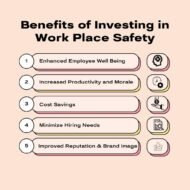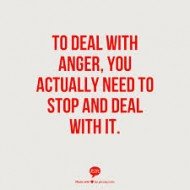Posted by Managementguru in Employee Safety, Human Resource, Productivity, Work Environment
on Jul 11th, 2023 | 0 comments

In today’s rapidly changing business landscape, organisations are constantly looking for ways to enhance their performance and maintain a competitive edge. While many factors contribute to a company’s success, one aspect that should never be overlooked is workplace safety. Investing in safety measures not only protects employees from harm but also yields significant benefits for businesses. In this article, we will explore why workplace safety is a smart business decision, considering both the immediate and long-term advantages it offers. Enhanced Employee Well-being By prioritising workplace safety, organisations demonstrate a commitment to the well-being of their employees. Safe working conditions foster a sense of trust, respect, and loyalty among the workforce. When employees feel safe and valued, their morale and job satisfaction increase, leading to improved productivity and reduced turnover rates. Something as simple as a good pair of work boots could save lives with a prevented slip, so investing in quality will be felt throughout the organisation. Increased Productivity and Efficiency Safety investments often go hand in hand with process improvements and risk mitigation strategies. Implementing safety protocols and providing necessary training equips employees with the knowledge and tools to perform their tasks efficiently and effectively. By reducing the likelihood of accidents, injuries, and illnesses, businesses can minimise downtime, maintain continuity in operations, and optimise productivity levels. Safe work environments also promote better focus and concentration, leading to higher quality output and fewer errors. Cost Savings Investing in workplace safety can result in substantial cost savings for businesses in the long run. While there may be upfront expenses associated with safety equipment, training, and compliance, these investments can significantly reduce the financial burden of accidents, injuries, and workers’ compensation claims. By preventing workplace incidents, companies avoid the direct costs of medical expenses, legal fees, and property damage. It helps to bear in mind that businesses with strong safety records often benefit from lower insurance premiums and improved employee insurance coverage terms. Improved Reputation and Brand Image Companies that prioritise safety earn a reputation as responsible and ethical employers. A strong safety culture becomes a valuable selling point for attracting top talent, as job seekers are increasingly concerned about the work environment. By creating a safe and healthy workplace, businesses can differentiate themselves from competitors and build a positive brand image that resonates with customers, partners, and stakeholders. Such a reputation can lead to increased customer loyalty, trust, and ultimately, improved business performance. Compliance with Legal and Regulatory Requirements Workplace safety is not just a moral obligation; it is also a legal requirement. Governments and regulatory bodies set specific standards and guidelines to protect employees’ rights and ensure their safety at work. Investing in safety measures allows businesses to comply with these regulations, avoiding potential penalties, fines, and legal disputes. By staying updated with safety regulations, organisations can demonstrate their commitment to ethical practices and create a culture of compliance, further bolstering their reputation. Investing in workplace safety is undeniably a smart business decision with far-reaching benefits. As businesses navigate the complexities of the modern world, incorporating workplace safety into their strategic plans is not only the right thing to do but also a wise investment that pays off in more ways than...

Posted by Managementguru in Accounting, Financial Accounting, Management Accounting
on Oct 24th, 2016 | 0 comments

Types of accounting information may be classified into four categories: Operating informationFinancial accounting informationManagement accounting information andCost accounting information 1. Operating Information: This is the kind of information which is required to conduct the day-to-day activities. Examples of operating information are: Amount of wages paid and payable to employeesInformation about the stock of finished goods available for sale andEach one’s cost and selling priceInformation about amounts owed to and owing by the business enterpriseInformation about stock of raw materials, spare parts and accessories and so on. By far, the largest quantity of accounting information provides the raw data (input) for financial accounting, management accounting and cost accounting. Spend Wisely 2. Financial Accounting: Financial accounting information is meant both for owners and managers and also for the use of individuals and agencies external to the business. This accounting is concerned with the recording of transactions for a business enterprise and the periodic preparation of various reports from such records. The records may be for general purpose or for a special purpose. Focus on the Long Term 3. Management Accounting: Management accounting makes use of both historical and estimated data in assisting management in daily operations and in planning for future operations. It deals with specific problems that is faced by enterprise managers at various organizational levels. The management accountant is often concerned with finding alternative courses of action and then helping to select the best one. For e.g. The accountant may help the finance manager in preparing plans for future financing or may help the sales manager in deciding the selling price to be fixed on a new product by providing suitable data. Generally management accounting information is used in three important management functions: ControlCo-ordination andPlanning 4. Marginal costing This is an important technique of management accounting which provides multi dimensional information that helps in decision making. Specialised Accounting Fields A number of specialized fields in accounting also have evolved besides financial accounting. Management accounting and cost accounting are the result of rapid technological advances and enhanced economic growth. The most important among them are explained below: 1. Tax Accounting: Tax accounting is all about the filing of tax returns and the consideration of the tax implications of proposed business transactions or alternative courses of action. Accountants specializing in this branch of accounting are familiar with the tax laws affecting their employer or clients and are up to date on administrative regulations and court decisions on tax cases. 2. International Accounting: This accounting is concerned with the special issues associated with the international trade of multinational business organizations or MNC’s. Accountants specializing in this area must be familiar with the influences that custom, law and taxation of various countries bring to bear on international operations and accounting principles. 3. Social Responsibility Accounting: This branch is the newest field of accounting and is the most difficult to describe. Social responsibility accounting is so called because it not only measures the economic effects of business decisions but also their social effects, which have previously been considered to be immeasurable. Social accounting is also known as social accounting and auditing, social and environmental accounting, corporate social reporting, corporate social responsibility reporting, non-financial reporting or accounting. Benefits of Social Accounting 4. Inflation Accounting: Inflation accounting is a term describing a range of accounting models designed to correct problems arising from historical cost accounting in the presence of highinflation and hyperinflation. Inflation accounting is used in countries experiencing high inflation or hyperinflation. 5. Human Resources Accounting: Human resource accounting is the process of identifying and reporting investments made in the human resources of an organization that are presently unaccounted for in the conventional accounting practices. It is an extension of standard accounting principles. This system of accounting...

Posted by Managementguru in Business Management, Decision Making, Financial Management, Marketing, Sales, Startups, Strategy
on Mar 4th, 2015 | 0 comments

A popular “Corporate Portfolio Analysis” technique is the result of pioneering effort of General Electric Company along with McKinsey Consultants which is known as the GE NINE CELL MATRIX. GE Nine-Box Matrix This is a strategy tool that offers a systematic approach for the multi business enterprises. It helps them to prioritize their investments among the various business units. It is a framework that evaluates business portfolio and provides further strategic implications. Each business is appraised in terms of two major dimensions – Market Attractiveness and Business Strength. If one of these factors is missing, then the business will not produce desired results. Neither a strong company operating in an unattractive market, nor a weak company operating in an attractive market will do very well. The vertical axis denotes industry attractiveness, which is a weighted composite rating based on eight different factors. They are: Market size and growth rateIndustry profit margins Intensity of Competition Seasonality Product Life Cycle Changes Economies of scale Technology Social, Environmental, Legal and Human Impacts What Does the Horizontal Axis Represent? It indicates business strength or in other words competitive position, which is again a weighted composite rating based on seven factors as listed below: Relative Market ShareProfit margins Ability to compete on price and qualityKnowledge of customer and market Competitive strength and weakness Technological capability Caliber of management The two composite values for industry attractiveness and competitive position are plotted for each strategic business unit (SBU) in a COMPANY’S PORTFOLIO. The PIE chart (circles) denotes the proportional size of the industry and the dark segments denote the company’s respective market share. The green zone suggests you to ‘go ahead’, to grow and build, pushing you through expansion strategies. Businesses in the green zone attract major investment. Red indicates that you have to adopt turnover strategies of divestment and liquidation or rebuilding approach. Advantages Helps to prioritize the limited resources in order to achieve the best returns.The performance of products or business units becomes evident. It’s more sophisticated business portfolio framework than the BCG matrix. Determines the strategic steps the company needs to adopt to improve the performance of its business portfolio. Disadvantages Needs a consultant or an expert to determine industry’s attractiveness and business unit strength as accurately as possible.It is expensive to conduct. It doesn’t take into account the harmony that could exist between two or more business units. PORTER’S FIVE FORCES-INDUSTRY...

Posted by Managementguru in Human Resource, Organisational behaviour, Training & Development
on Jul 28th, 2014 | 0 comments

Anger Management What is Anger? To put in a layman’s perspective, When something doesn’t happen the way we want it to When somebody tries to dominate us When we are forced to do something When we get disappointed if things are not favorable and many more situations that kindle within us a feeling – which is called frustration if the intensity is mild and rage if the intensity is huge. This type of anger pertains to “self”; anger also erupts if our loved ones, near and dear ones experience threat or when you want to oppose a social stigma or when you feel helpless in a situation.” On top of all this “A Hungry Man is always Angry“, Do you agree with me? I want to ask a simple question, “Are the poor to blame for being poor?“. Well, this is a social problem and every one of us must be angry if the people of our own country are below the poverty line and not being able to eat atleast twice a day. How do we define Anger Management? Coming to Anger Management, it is training for temper control and is the skill of remaining calm. It has been described as deploying anger successfully. Anger management is the process of learning to recognize signs that you’re becoming angry, and taking action to calm down and deal with the situation in a positive way. We have to understand the crucial fact that ” In no way does anger management mean holding the anger in or trying to keep from feeling anger. Anger is a normal human emotion, a healthy one when it is expressed appropriately“. What Makes People Angry? I want to list down some of the most common things that make people angry. The most common factors that make people angry are: Grief – losing a loved one. Sexual frustration Rudeness Tiredness Hunger Pain Withdrawal from drugs or some medications Some physical conditions, such as pre-menstrual syndrome Physical illness Mental illness Alcohol, some drugs, alcohol abuse, drug abuse Injustice Being teased or bullied Humiliation Embarrassment Deadlines Traffic jams Disappointment Sloppy service Failure Infidelity Burglary Financial problems Being told you have a serious illness Courtesy – http://www.medicalnewstoday.com/ You know, I get angry even if I hear somebody munching or chewing something and I can never stand that sound! I googled to know more about my shortcoming and was relieved to find that I have good company on this issue. Read this news: ‘The sound of my boyfriend chewing makes me want to strangle him’: Model, 20, has a phobia of NOISE which makes her fly into a rage when she hears someone eating.” (This medical condition is called “Misophonia” which literally means hatred of sound and seems to be a neurological disorder). Faith Watson, 20, has misophonia – the hatred of sound Certain noises – including chewing – make her irrationally angry At meals she has to have the TV on so she can’t hear people chewing She had to drop out of college after being tormented by classroom noises Now she has been officially diagnosed, she is rebuilding her life and trying to make a career as a model Courtesy – http://www.dailymail.co.uk/health/ I personally feel that people have become restless in general and want everything to happen in a jiffy. Rationale and Logic have taken a back seat and we all are evolving as one group with SUPER-EGO and IMPATIENCE. What is the reason behind this? Are we becoming insensitive to others’ feelings? Have we forgotten to enjoy moments of happiness how small it may be? In my opinion there are only two types of anger: Constuctive Anger – that which helps to...

Posted by Managementguru in Human Resource, Quotes and Quotes Only, Training & Development
on Jul 6th, 2014 | 0 comments

Popular HR Quotes by Industry Experts and Management Scholars We have compiled 50 top notch hr quotes from doyens in the field of business and management that will sure fire inspire you with creative ideas. 1. “Great Vision Without Great People Is Irrelevant.” -Jim Collins, Good To Great 2. “Human Resources Isn’t A Thing We Do. It’s The Thing That Runs Our Business.” -Steve Wynn, Wynn Las Vegas 3. “You Need To Have A Collaborative Hiring Process.” -Steve Jobs, Apple 4. “You Can’t Teach Employees To Smile. They Have To Smile Before You Hire Them.” -Arte Nathan, Wynn Las Vegas 5. “Never Hire Someone Who Knows Less Than You Do About What He’s Hired To Do.” -Malcolm Forbes, Forbes Top 50 HR Quotes 6. “When Hiring Key Employees, There Are Only Two Qualities To Look For: Judgement And Taste. Almost Everything Else Can Be Bought By The Yard.” John W. Gardner 7. “Recently, I Was Asked If I Was Going To Fire An Employee Who Made A Mistake That Cost The Company $600,000. No, I Replied, I Just Spent $600,000 Training Him. Why Would I Want Somebody To Hire His Experience?” -Thomas John Watson Sr., Ibm 8. “It’s More Than Just Selling Pizzas. It’s Being A Good Fit For The Community. We Hire Based On The Betterment Of The Community As Much As Anything.” -Mark Starr, David’s Pizza. 9. “You Can Have The Best Strategy And The Best Building In The World, But If You Don’t Have The Hearts And Minds Of The People Who Work With You, None Of It Comes To Life.” -Renee West, Luxor And Excalibur Hotel 10. “I am convinced that nothing we do is more important than hiring and developing people. At the end of the day you bet on people, not on strategies.” -Lawrence Bossidy, Ge CURRENT TRENDS IN HRD 11. “Do Not Hire A Man Who Does Your Work For Money, But Him Who Does It For The Love Of It.” -Henry David Thoreau, Life Without Principle 12. “If You Think Hiring Professionals Is Expensive, Try Hiring Amateurs” -Anonymous 13. “The Key For Us, Number One, Has Always Been Hiring Very Smart People.” -Bill Gates, Microsoft 14. “Time Spent On Hiring Is Time Well Spent.” -Robert Half 15. “I Hire People Brighter Than Me And Then I Get Out Of Their Way” -Lee Iacocca, Ford 16. “You Cannot Push Anyone Up The Ladder Unless He Is Willing To Climb.” -Andrew Carnegie 17. “Management Is Nothing More Than Motivating Other People.” -Lee Iacocca, Ford 18. “There Are Few, If Any, Jobs In Which Ability Alone Is Sufficient. Needed, Also, Are Loyalty, Sincerity, Enthusiasm And Team Play.” -William B. Given, Jr. 19. “When People Go To Work, They Shouldn’t Have To Leave Their Hearts At Home.” -Betty Bender 20. “One Machine Can Do The Work Of Fifty Ordinary Men. No Machine Can Do The Work Of One Extraordinary Man.” -Elbert Hubbard 21. “To Find Joy In Work Is To Discover The Fountain Of Youth.” -Pearl S. Buck 22. “One Of The Symptoms Of An Approaching Nervous Breakdown Is The Belief That One’s Work Is Terribly Important.” -Bertrand Russell 23. “Opportunity Is Missed By Most People Because It Is Dressed In Overalls And Looks Like Work.” -Thomas A. Edison 24. “Far And Away The Best Prize That Life Offers Is The Chance To Work Hard At Work Worth Doing.” -Theodore Roosevelt 25. ”Being Busy Does Not Always Mean Real Work. The Object Of All Work Is Production Or Accomplishment And To Either Of These Ends There Must Be Forethought, System, Planning, Intelligence, And Honest Purpose, As Well As Perspiration. Seeming To Do Is Not Doing.” -Thomas A. Edison 26. “Going To Work For A Large Company Is Like...










